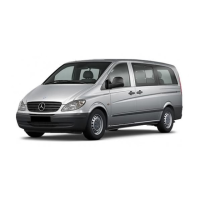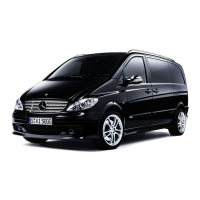the belt tensioners are the first to be trig-
gered by the airbag control unit.
The front airbags are not deployed unless
a second activation threshold is reached,
i.e. there is a higher rate of vehicle decel-
eration in a longitudinal direction.
! The seat belt for the middle seat is only fit-
ted with a belt tensioner on vehicles with a co-
driver's double airbag.
Criteria for triggering belt tensioners
and airbags
In the first stages of a collision, the sensor
in the airbag control unit evaluates physi-
cal data, such as duration, direction and
rate of vehicle deceleration or acceleration
in order to determine whether it is neces-
sary to trigger the belt tensioners and/or
deploy the airbags.
The triggering thresholds for the belt ten-
sioners and airbags are variable and are
adapted to the rate of vehicle decelera-
tion. This process is pre-emptive in nature
since the airbag must be deployed during,
and not at the end of, the collision.
i Airbags are not deployed in all types of ac-
cident. They are controlled by a complex sen-
sor system and evaluation logic. This process is
pre-emptive in nature as airbag deployment
must take place during the impact and must be
adapted to provide calculated, additional pro-
tection for the vehicle occupants. Not all air-
bags are deployed in an accident.
The various airbag systems work independently
of each other. However, the deployment of
each individual system depends on the type of
impact (head-on or side impact) and the se-
verity of the impact (in particular, the vehicle's
rate of deceleration or acceleration) as deter-
mined by the control system in the initial
stages of the accident.
Vehicle deceleration or acceleration and
the direction of the force are essentially
determined by:
I
the distribution of the force during the
impact
I
the collision angle
I
the deformation characteristics of the
vehicle
I
the characteristics of the object with
which the vehicle has collided, e.g. the
other vehicle
Factors which can only be seen and meas-
ured after the collision has occurred, do
not determine whether the airbags are de-
ployed and do not provide an indication of
their deployment.
The vehicle may be considerably deformed
without an airbag being deployed if, for ex-
ample, only relatively easily deformable
parts, such as the bonnet or wings, have
been hit and the required rate of decelera-
tion has not been reached. It is also possi-
ble that airbags may be deployed even
though the vehicle is only slightly de-
formed, if, for example, very rigid vehicle
parts such as the longitudinal members
are hit in an accident and the rate of de-
celeration is sufficient.
Belt tensioners, belt force limiters
The front seat belts have belt tensioners.
Belt tensioners tighten the seat belts in an
accident, pulling them close against the
seat occupant's body.
i Belt tensioners do not correct:
I
incorrect sitting positions
I
incorrectly worn seat belts
Belt tensioners do not pull occupants back to-
wards the backrest.
If the seat belt is also equipped with a belt
force limiter, the force exerted by the seat
belt on the seat occupant is reduced.
Safety
Occupant safety
40
2
Nur fuer internen Gebrauch

